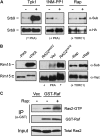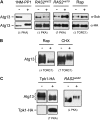Antagonistic interactions between the cAMP-dependent protein kinase and Tor signaling pathways modulate cell growth in Saccharomyces cerevisiae
- PMID: 21078689
- PMCID: PMC3030488
- DOI: 10.1534/genetics.110.123372
Antagonistic interactions between the cAMP-dependent protein kinase and Tor signaling pathways modulate cell growth in Saccharomyces cerevisiae
Abstract
Eukaryotic cells integrate information from multiple sources to respond appropriately to changes in the environment. Here, we examined the relationship between two signaling pathways in Saccharomyces cerevisiae that are essential for the coordination of cell growth with nutrient availability. These pathways involve the cAMP-dependent protein kinase (PKA) and Tor proteins, respectively. Although these pathways control a similar set of processes important for growth, it was not clear how their activities were integrated in vivo. The experiments here examined this coordination and, in particular, tested whether the PKA pathway was primarily a downstream effector of the TORC1 signaling complex. Using a number of reporters for the PKA pathway, we found that the inhibition of TORC1 did not result in diminished PKA signaling activity. To the contrary, decreased TORC1 signaling was generally associated with elevated levels of PKA activity. Similarly, TORC1 activity appeared to increase in response to lower levels of PKA signaling. Consistent with these observations, we found that diminished PKA signaling partially suppressed the growth defects associated with decreased TORC1 activity. In all, these data suggested that the PKA and TORC1 pathways were functioning in parallel to promote cell growth and that each pathway might restrain, either directly or indirectly, the activity of the other. The potential significance of this antagonism for the regulation of cell growth and overall fitness is discussed.
Figures








Similar articles
-
The Tor and PKA signaling pathways independently target the Atg1/Atg13 protein kinase complex to control autophagy.Proc Natl Acad Sci U S A. 2009 Oct 6;106(40):17049-54. doi: 10.1073/pnas.0903316106. Epub 2009 Sep 21. Proc Natl Acad Sci U S A. 2009. PMID: 19805182 Free PMC article.
-
Nutrient Control of Yeast Gametogenesis Is Mediated by TORC1, PKA and Energy Availability.PLoS Genet. 2016 Jun 6;12(6):e1006075. doi: 10.1371/journal.pgen.1006075. eCollection 2016 Jun. PLoS Genet. 2016. PMID: 27272508 Free PMC article.
-
Interaction of TOR and PKA Signaling in S. cerevisiae.Biomolecules. 2022 Jan 26;12(2):210. doi: 10.3390/biom12020210. Biomolecules. 2022. PMID: 35204711 Free PMC article. Review.
-
TORC1 signaling regulates cytoplasmic pH through Sir2 in yeast.Aging Cell. 2020 Jun;19(6):e13151. doi: 10.1111/acel.13151. Epub 2020 May 25. Aging Cell. 2020. PMID: 32449834 Free PMC article.
-
Nutritional control via Tor signaling in Saccharomyces cerevisiae.Curr Opin Microbiol. 2008 Apr;11(2):153-60. doi: 10.1016/j.mib.2008.02.013. Epub 2008 Apr 8. Curr Opin Microbiol. 2008. PMID: 18396450 Free PMC article. Review.
Cited by
-
Target of rapamycin signaling regulates high mobility group protein association to chromatin, which functions to suppress necrotic cell death.Epigenetics Chromatin. 2013 Sep 2;6(1):29. doi: 10.1186/1756-8935-6-29. Epigenetics Chromatin. 2013. PMID: 24044743 Free PMC article.
-
A Hybrid-Body Containing Constituents of Both P-Bodies and Stress Granules Forms in Response to Hypoosmotic Stress in Saccharomyces cerevisiae.PLoS One. 2016 Jun 30;11(6):e0158776. doi: 10.1371/journal.pone.0158776. eCollection 2016. PLoS One. 2016. PMID: 27359124 Free PMC article.
-
Sch9 regulates ribosome biogenesis via Stb3, Dot6 and Tod6 and the histone deacetylase complex RPD3L.EMBO J. 2011 Jul 5;30(15):3052-64. doi: 10.1038/emboj.2011.221. EMBO J. 2011. PMID: 21730963 Free PMC article.
-
Transcription by the Three RNA Polymerases under the Control of the TOR Signaling Pathway in Saccharomyces cerevisiae.Biomolecules. 2023 Apr 3;13(4):642. doi: 10.3390/biom13040642. Biomolecules. 2023. PMID: 37189389 Free PMC article. Review.
-
Sphingolipid accumulation causes mitochondrial dysregulation and cell death.Cell Death Differ. 2017 Dec;24(12):2044-2053. doi: 10.1038/cdd.2017.128. Epub 2017 Aug 11. Cell Death Differ. 2017. PMID: 28800132 Free PMC article.
References
-
- Abramoff, M. D., P. J. Magelhaes and S. J. Ram, 2004. Image processing with ImageJ. Biophotonics Int. 11 36–42.
-
- Araki, T., Y. Uesono, T. Oguchi and E. A. Toh, 2005. LAS24/KOG1, a component of the TOR complex 1 (TORC1), is needed for resistance to local anesthetic tetracaine and normal distribution of actin cytoskeleton in yeast. Genes Genet Syst. 80 325–343. - PubMed
-
- Bahn, Y. S., C. Xue, A. Idnurm, J. C. Rutherford, J. Heitman et al., 2007. Sensing the environment: lessons from fungi. Nat. Rev. Microbiol. 5 57–69. - PubMed
-
- Bishop, A. C., K. Shah, Y. Liu, L. Witucki, C. Kung et al., 1998. Design of allele-specific inhibitors to probe protein kinase signaling. Curr. Biol. 8 257–266. - PubMed
Publication types
MeSH terms
Substances
Grants and funding
LinkOut - more resources
Full Text Sources
Other Literature Sources
Molecular Biology Databases

